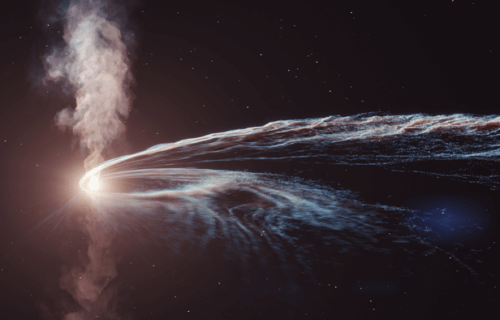CAMBRIDGE, Mass. — A black hole has just burped out a star it sucked up years ago. The black hole is currently throwing up the shredded star at half the speed of light, although astronomers aren’t quite sure why it took so long for the star material to come out. This unusual phenomenon is giving scientists more insight into the feeding patterns of black holes — especially after gobbling down a starry meal.
The small star — estimated to be one-tenth the mass of the Sun — was ripped apart when it traveled too close to a black hole sitting 665 million light years away from Earth. Black holes swallow up stars all the time, so the event did not raise a lot of eyebrows at first. Fast forward nearly three years later, researchers from the Harvard–Smithsonian Center for Astrophysics say the same black hole has not dined again since eating the star. Moreover, astronomers observed it regurgitating parts of the star material back into space.
“This caught us completely by surprise — no one has ever seen anything like this before,” says research associate and lead study author Yvette Cendes in a university release.
The black hole came back on the radar when astronomers looked back at past tidal disruption events (TDEs) — when stars that wander too close to black holes are pulled in by strong gravitational fields — in the past few years. The result of a wandering star is spaghettification, where it is stretched out like noodles before being chewed up and (in this case, partially) devoured by the black hole.
What exactly is black hole spaghettification?
Spaghettification is normally a wandering star’s final demise. However, in June 2021, radio data from a lab in New Mexico spotted the same black hole reappearing in the sky. Radio waves can detect black holes and the material it spews out when a star is first devoured by a black hole. Astronomers liken the event to black holes being messy eaters with not everything making it in. When the star is flung back out to space, the noodle-like shape first spirals around the black hole, causing it to heat up and create a flash that can be seen millions of light years away.
The TDE for this event was named AT2018hyz and the team gathered data on the multiple wavelengths of light in space using radio telescopes. After the TDE, however, there were no signs of the black hole spitting back up any pieces of the star.
“In AT2018hyz there was radio silence for the first three years, and now it’s dramatically lit up to become one of the most radio luminous TDEs ever observed,” adds co-author Edo Berger, a professor of astronomy at Harvard University.
Normally, the black hole burps out any leftover material immediately following its stellar meal — not years later.
“It’s as if this black hole has started abruptly burping out a bunch of material from the star it ate years ago,” observes Cendes.
The black hole really blasted out this star debris
The black hole held in this burp for years, and it showed. Researchers say the outflow of star material traveled out at 50 percent of the speed of light. Usual TDEs emit pieces of devoured stars at 10 percent of the speed of light.
“This is the first time that we have witnessed such a long delay between the feeding and the outflow,” Berger concludes. “The next step is to explore whether this actually happens more regularly and we have simply not been looking at TDEs late enough in their evolution.”
The study detailing the unusual phenomenon is published in The Astrophysical Journal.

